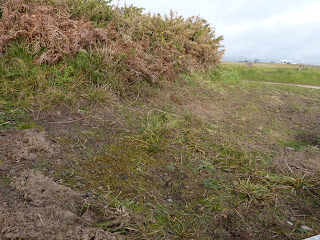This morning I went
for a walk with the family to the top of Mynydd Troed which overlooks Llangorse
Lake and reaches a reasonable height of 609m. Looking up from where we
parked, the hill didn’t look to have much potential for bryos, with few rock
outcrops and no signs of seepages or streams. The path up passed through
mostly heathland where the bryophyte cover consisted almost entirely of a mix
of Pleurozium schreberi, Hylocomium splendens and Pseudoscleropodium purum, although I did manage
to spot a bit of one of my favourite liverworts Ptilidium ciliare at the heathy edge of a lichen covered boulder
poking out of the ground. Halfway up the hill an outcrop about 1m high
proved to be quite base-rich with some very nice patches of Tortella bambergeri (as was), sheets of
very chunky Hypnum lacunosum and
scattered tufts of Grimmia pulvinata.

Other rock outcrops slightly further up the slope were acidic and largely
devoid of moss, with just a few patches of Dicranoweissia
cirrata and Grimmia trichophylla.
From near the trig point is a nice view of the ridge above Pengenffordd and today it was topped off with a bit of snow. In the valley below are the remains of what must have been an impressive castle in its day. If you ever visit this castle take a look at
the walls and outcrops on the lowest parts as they support one of the
largest populations of Encalypta vulgaris
in Breconshire.
Just north of the trig point are some small crags, about
3m to 4 m high. Again these proved to be very acidic with lots
of Hypnum cupressiforme, some Isothecium myosuroides and a lot of algae.
At the base of the crags though were a few more interesting species such as Marsupella emarginata and a few crevices had
the likes of Amphidium mougeotii and Fissidens adianthoides.
A
nearby grassy area held a few frosted shoots of Rhytidiadelphus loreus amongst a turf of mostly R. squarrosus.
Back down
near the car I noticed a small mound, probably an old anthill, with a bit of Ceratodon and a small Bryum that looked like rubens, for a change I had remembered to
bring my handlens and so was able to see the bright red tubers amongst the rhizoids.
I must remember to make a point of looking for this moss as there are very few
Breconshire records.
So the hill seemed to be as bryologically poor as it first looked, although I didn't wander far from the path, but at least
I got out in the field, a rare event this winter, and made some records for a
poorly recorded square. Also that Pengenffordd ridge looks inviting, with
some better crags towards the Hay-on-Wye end and hopefully I'll get up there in
2018.


















































